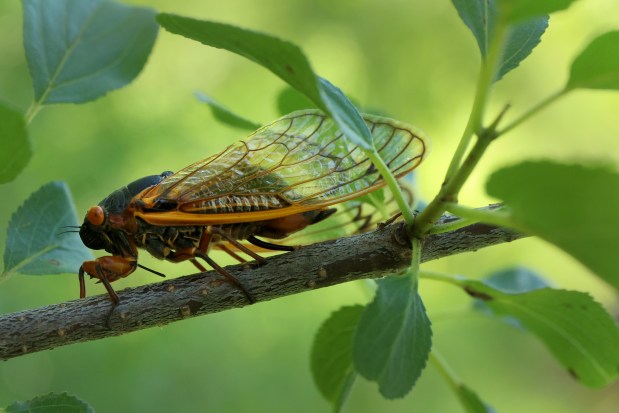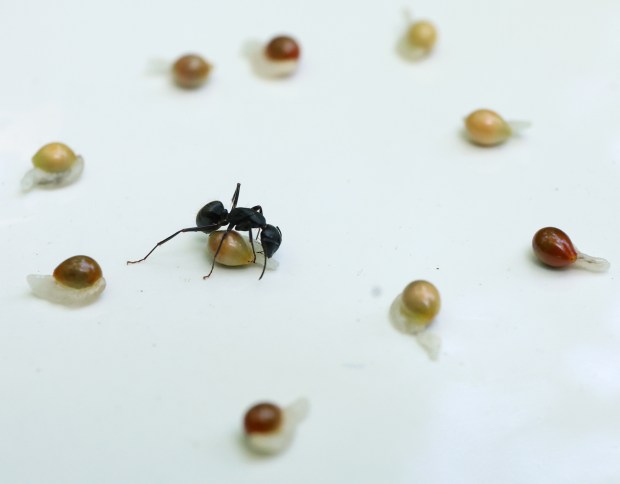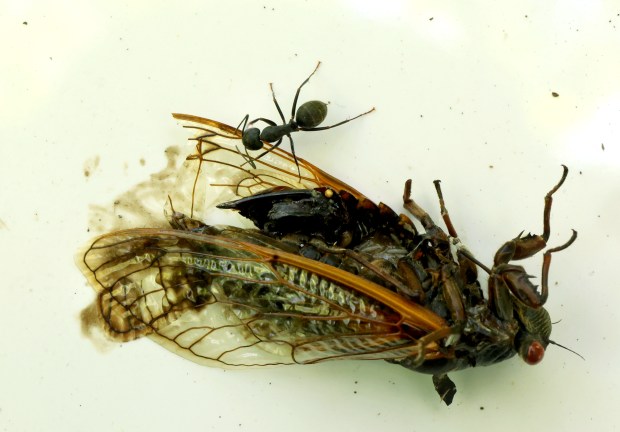In a wooded clearing in Lake Forest, a team of researchers crouched close to the grass. They watched as hundreds of ants crawled over seeds, sipped sugar water and indulged in a seasonal treat: cicadas.
Ants’ foraging activities may seem trivial. But to these scientists, they’re a gateway to unraveling the little-known impact on forest food webs when billions of cicadas emerge from the ground in Illinois.
“We’re trying to look at the interconnectedness of all of this,” said researcher Sean Menke, an ant expert and biology professor at Lake Forest College.
It’s one of the many unknowns surrounding the cicadas, which remain difficult to study because of their yearslong dormancy. But scientists suspect that the insect’s emergence has a cascading effect on intertwined food chains — potentially rewiring the complex energy flows between organisms for years to come.
For example, previous studies have shown that cicadas form a key component of birds’ diets during emergence years. This, in turn, eases the predation pressure on caterpillars. But booming caterpillar populations could spike damage to oak trees.
“It’s fun, it’s exciting and intimidating all at once, because really nobody knows any of this,” Menke said of their research.
‘An all-you-can-eat buffet’
Illinois is the site of rare dual emergence this year. Cicadas from Brood XIX, four species that appear every 13 years in the Southeast, and Brood XIII, three species that appear every 17 years in northern Illinois, will appear simultaneously. The last time the broods converged was in 1803.
A cicada emergence is known as a regional biomass pulse, or a sudden influx of resources inundating an ecosystem. The insect explosion won’t last long — cicadas die after about five weeks above ground. Shortly after their eggs hatch, the nymphs burrow into the soil and repeat the cycle.
To survive, the insects use a predator satiation strategy. The sheer volume of bugs is so great that it overwhelms predators, reducing an individual cicada’s chance of being eaten.
In other words? It’s “an all-you-can-eat buffet” for birds, said Zoe Getman-Pickering, an ecologist and coordinator for the Energy Transition Institute at UMass Amherst.
“We joke that cicadas are kind of awkward. We’ve seen them fly into trees and things,” Getman-Pickering said. “Compared to other insects, they’re slow flyers, they’re big, and because there’s so many of them, they’re so easy to catch.”
They’re also not poisonous, which allows most species with diet flexibility to indulge. Take Brookfield Zoo, for example, where brown bears, spider monkeys and even tamarinds are among those sampling cicadas. The protein-rich, low-fat bugs are a nutritious alternative to crickets or mealworms.
“Fortunately for our animals, and maybe unfortunately for the cicadas, the cicadas don’t have a lot of natural defenses,” said Sathya Chinnadurai, senior vice president of animal health, and welfare at the zoo. “They’re opportunistically eating a new food source available to them.”
The same phenomena occur in the wild. During the 2021 Brood X emergence in Maryland, Getman-Pickering was among a team studying the effect of birds preying on cicadas. The researchers observed 80 species of birds eating the insect, mainly robins and sparrows.

The team also placed clay caterpillars on tree branches and counted the number of bird strikes. When the nymphs appeared in May, bird strike frequency dropped from 30% to less than 10%. The team observed a substantial increase in caterpillar populations, and consequently, a spike in white oak leaf damage.
“But because we saw such a wide range of birds changing their behavior, I think it’s pretty likely that the birds of Illinois will be doing the same thing,” Getman-Pickering said.
The long-term effect on forest health is less clear. Some research suggests that trees quickly bounce back from damage during the cicada years. In fact, oaks may benefit overall because of decomposing cicada carcasses fertilizing the soil, according to Getman-Pickering.
For birds, a burst of cicadas serves as a welcome reprieve as they face other environmental stressors – climate change, habitat loss, pollution. It could potentially lead to a population boost.
“It’s not solving these problems, but it is a moment of respite where they can get all of the food they need and support really large broods of babies,” Getman-Pickering said.
‘Ants are the unsung heroes’
Martha Weiss, a Georgetown University environmental studies professor, and John Lill, a professor of biology at George Washington University, collaborated with Getman-Pickering on the Maryland cicada study. Now, the pair’s fascination with cicadas has led them to Lake Forest. Their ongoing ant study with Menke began last summer.
Why ants? The tiny insects are a key pillar of the trophic dynamics of forested areas. Like birds, their behavior when cicadas appear could have a sweeping impact on ecosystems, the team said.
“Ants are the unsung heroes of a lot of forested areas,” Weiss said.
During emergence years, ants often feed upon the abundance of dying cicadas. The researchers wonder if ants will then divert from their typical foraging activities that help regulate the ecosystem.
“Anything that changes their normal foraging behavior, the time, where they’re going, what they’re looking for, is likely to have a reverberating impact,” Lill said.
The researchers have placed various food sources at five sites across the forest floor. Ants are very in tune to their nutritional needs, and will seek out the substances they need most, according to Weiss.
In other words, because ants are foraging for cicadas, they’ll be less drawn to other protein-rich food items, such as fruit flies and bloodroot seeds. It’s unclear, however, how their high consumption of protein will affect their needs for other nutrients, like sugar.

“There’s one hypothesis that (cicadas) are not going to change their sugar needs … the other hypothesis is that as they add more nutrients from the cicadas, they’re going to need more sugar to balance that out,” Menke said.
That matters because ants usually farm sugar from aphids, which excrete honeydew. In the process, ants shelter aphids from predators. But if ants are no longer seeking out sugar, aphids will be more vulnerable.
“If the ants walk off the job and don’t tend to the aphids, (aphids) are actually less protected,” Weiss said.
The team is monitoring aphid populations on several plants to track any adverse effects. The insect, along with ants, is also an integral piece of trophic dynamics.
“Aphids are an important link in the food chain, like any other herbivore,” Lill said.
The study is expected to conclude in the summer of 2026, which will allow the team to see how the forest recovers in the years after the cicada emergence.
It’s just one glimpse at cicadas’ indirect ripple on food webs — but questions still shroud the process. Even less is known about what occurs below ground. Scientists aren’t sure exactly how cicada nymphs interact with other organisms in the soil, including ants.
“When we’re talking about these alternative hypotheses, we just don’t know,” Menke said. “There is no baseline data on how this system works in terms of ants and the effects of the cicada emergence.”
For Getman-Pickering, it seems to add an air of mystique to the bumbling insect. To a certain extent, the complex and interwoven interactions of birds, ants, caterpillars and other organisms are transformed by cicadas.
“I think it’s worth acknowledging that it’s not good or bad, it’s natural and complicated,” Getman-Pickering said. “It’s a really beautiful insight into how interconnected all of these species are.”




